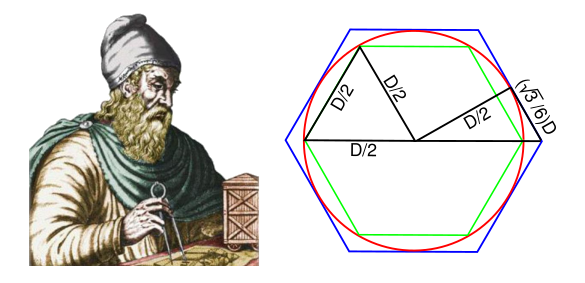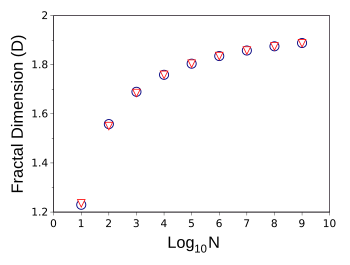The Normality of Pi
September 5, 2016
The
ratio of a
circle's circumference to its
diameter, a
mathematical quantity known as
pi (Greek letter, π), or as Archimedes' constant, is valid for any circle. The name of the
Greek mathematician,
Archimedes (287-212 BC), is attached to this constant, since he was the first to give a close numerical
estimate of its value. A
scholarly paper also credits Archimedes as the first the understand that the ratio of the circumference of a circle to its diameter is a constant that's the same for
all circles.[1] This fact, in itself, has a significance that's rarely discussed.
You can, of course, thread a
string around a circle, and then measure the
length of the string and the circle's diameter with a
ruler to get a value of pi. That, however, is an
experiment, and it's not something a proper mathematician does. I presented several experimental methods for the determination of pi in two earlier articles (
Buffon's Needle, July 19, 2010, and
Another Piece of Pi, July 28, 2010.
Archimedes placed
hexagons within and around a circle, and he reasoned that pi has a value between the
perimeters of the inner and outer hexagon. Not stopping there, Archimedes proceeded to 96-sided
polygons, showing that 223/71 ≤ π ≤ 22/7; that is, 3.1408 ≤ π ≤ 3.1429. If we average these, we get 3.141855, which is within a hundredth of a percent of the value of pi. I use just the first eleven
digits of pi, 3.1415926535, in most of my
computer programs. That last 5 should be
rounded up to 6, but I don't bother. A
single-precision (float) in
C is precise to about 7 digits.

Archimedes (287-212 BC) and his method of hexagons for an estimate of the value of pi. The inner hexagon gives a lower limit of 3.0, while the outer hexagon sums to 3.4641... (Left image via Wikimedia Commons. Right image created using Inkscape)
I stop at eleven digits, but pi has many more; in fact, an
infinity of digits. That's because pi is an
irrational number, just like the
square-root of two. I wrote about irrational numbers and the square-root of two in a
recent article (The Square Root of Two, June 6, 2016). The square-root of two was the first number
proven to be irrational, and there's a
legend that the
gods caused
Hippasus (c. 450 BC), the discoverer of this fact, to
drown at
sea for this
unholy revelation.
Examination of any segment of the digits of pi suggests that its digits are
random. A closer look using computer techniques reaffirms this idea. It's
conjectured that pi is a
normal number; that is, an irrational number whose digits occur with the same likelihood. This is true in every
number base, not just our commonly used
base 10. If pi were normal, then none of its digit, or any combination of digits, occurs more frequently than any other. Digits of pi are used as random numbers in the
Blowfish cipher.

The first few decimal (left) and hexadecimal (right) digits of pi. Presently, about 10 trillion (1013) decimal digits of pi are known. (Created using Inkscape.)
While it's possible to do improved
statistical tests of the
distribution of the digits of pi, since more and more of its digits are being amassed, there's no real proof of pi's normality. Not only have people looked at the distribution of the digits, themselves, but they've looked at the distribution of pairs of digits (dyads), groups of three digits (triads), up to larger n-ads. All these tests indicate a normal number. While it's almost certainly
true that pi and its irrational cousins, √2 and
e (the base of
natural logarithms) are normal numbers, no mathematician has actually proved this.
A recent paper on
arXiv by
Carlos Sevcik of the
Instituto Venezolano de Investigaciones Científicas (IVIC, Caracas, Venezuela) has added to the evidence of pi's normality, not with an actual proof, but with a different type of statistical test. Sevcik did a
fractal analysis of pi's digits, and he showed that it gave the same result as that for a
uniformly distributed random succession of independent decimal digits. Sevcik also detected that this measure of randomness for pi
converged on the ideal result as more digits of pi were included.[2]

The father of fractals, Benoit Mandelbrot (1924-2010), at the École Polytechnique Fédérale de Lausanne, March, 2007.
The word "fractal," originated with him.
(Wikimedia Commons image by Rama.)
The fractal analysis would detect whether there are complex structures that exist in the sequence of pi's digits, since it looks at the sequence as a whole, and not just its parts. In this analysis, the digits of pi are considered to be periodic samples of a
waveform. For this analysis, Sevcik generated his own list of digits of pi using a
variant of the Ramanujan series developed by the famed
Chudnovsky brothers. To illustrate how far computing has progressed, this operation took just 1929 seconds on his
Linux computer.[2]
If you want to compare the sequence of pi digits to random numbers, you need a good sequence of random numbers, which is not a trivial undertaking. Sevcik used the
Mersenne_Twister (MT19937), a
random number generator that's passed the
DIEHARD suite of statistical tests.[2]
While Sevcik's result is just another statistical argument for the normality of pi, his results, as shown in the
graph, are convincing. His fractal analysis demonstrates that the digits of pi and a sequence of random numbers show the same fractal behavior.

Fractal dimension of the digits of pi (circles) compared with that of a sequence of random integers (triangles) for sequences up to a billion (109).
(Graphed using Gnumeric from data in tables 1-2 of ref. 2.[2]
![]()
References:
- David Richeson, "Circular reasoning: who first proved that C/d is a constant?" arXiv, March 14, 2013.
- Carlos Sevcik, "Fractal analysis of π normality," arXiv, July 28, 2016.
Permanent Link to this article
Linked Keywords: Ratio; circle; circumference; diameter; mathematics; mathematical; pi; Greek; mathematician; Archimedes (287-212 BC); constant; approximation; estimate; scholarly method; academic publishing; paper; fiber; string; length; ruler; experiment; hexagon; perimeter; polygon; numerical digit; computer program; rounding; single-precision floating-point format; single-precision (float); C (programming language); Archimedes (287-212 BC); approximation; estimate; pi; Wikimedia Commons; Inkscape; infinity; irrational number; square-root of two; mathematical proof; legend; deity; god; Hippasus (c. 450 BC); drowning; drown; ocean; sea; sacrilege; unholy; randomness; random; conjecture; normal number; radix; number base; decimal; base 10; Blowfish cipher; hexadecimal; statistics; statistical; probability distribution; truth; mathematical constant, e; natural logarithm; arXiv; Carlos Sevcik; Venezuelan Institute for Scientific Research; Instituto Venezolano de Investigaciones Científicas (IVIC, Caracas, Venezuela); fractal analysis; uniform distribution; convergent; converge; fractal; Benoit Mandelbrot (1924-2010); École Polytechnique Fédérale de Lausanne; Rama; waveform; Chudnovsky algorithm; Ramanujan series; Chudnovsky brothers; Linux; Mersenne Twister (MT19937); random number generator; Diehard tests; DIEHARD; Cartesian coordinate system; graph; fractal dimension; Gnumeric.